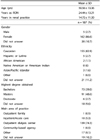1. Eknoyan G, Levin A, Levin NW. National Kidney Foundation. K/DOQI clinical practice guidelines for bone metabolism and disease in chronic kidney disease. Am J Kidney Dis. 2003; 42:Suppl 3. S1–S201.
2. Khoueiry G, Waked A, Goldman M, El-Charabaty E, Dunne E, Smith M, Kleiner M, Lafferty J, Kalantar-Zadeh K, El-Sayegh S. Dietary intake in hemodialysis patients does not reflect a heart healthy diet. J Ren Nutr. 2011; 21:438–447.

3. Biruete A, Jeong JH, Barnes JL, Wilund KR. Modified nutritional recommendations to improve dietary patterns and outcomes in hemodialysis patients. J Ren Nutr. 2017; 27:62–70.

4. Calvo MS, Uribarri J. Contributions to total phosphorus intake: all sources considered. Semin Dial. 2013; 26:54–61.

5. Noori N, Sims JJ, Kopple JD, Shah A, Colman S, Shinaberger CS, Bross R, Mehrotra R, Kovesdy CP, Kalantar-Zadeh K. Organic and inorganic dietary phosphorus and its management in chronic kidney disease. Iran J Kidney Dis. 2010; 4:89–100.
6. St-Jules DE, Goldfarb DS, Sevick MA. Nutrient non-equivalence: does restricting high-potassium plant foods help to prevent hyperkalemia in hemodialysis patients? J Ren Nutr. 2016; 26:282–287.

7. United States Renal Data System. 2016 USRDS Annual Data Report: Epidemiology of Kidney Disease in the United States. Bethesda, MD: National Institutes of Health, National Institute of Diabetes and Digestive and Kidney Diseases;2016.
8. Burrowes JD, Russell GB, Rocco MV. Multiple factors affect renal dietitians' use of the NKF-K/DOQI Adult Nutrition Guidelines. J Ren Nutr. 2005; 15:407–426.

9. Hall-McMahon EJ, Campbell KL. Have renal dietitians successfully implemented evidence-based guidelines into practice? A survey of dietitians across Australia and New Zealand. J Ren Nutr. 2012; 22:584–591.

10. Johnston B, Coole C, Narayanasamy M, Feakes R, Whitworth G, Tyrell T, Hardy B. Exploring the barriers to and facilitators of implementing research into practice. Br J Community Nurs. 2016; 21:392–398.

11. Metcalfe C, Lewin R, Wisher S, Perry S, Bannigan K, Moffett JK. Barriers to implementing the evidence base in four NHS therapies: dietitians, occupational therapists, physiotherapists, speech and language therapists. Physiotherapy. 2001; 87:433–441.

12. McEvoy MP, Williams MT, Olds TS. Evidence based practice profiles: differences among allied health professions. BMC Med Educ. 2010; 10:69.

13. Hand RK, Steiber A, Burrowes J. Renal dietitians lack time and resources to follow the NKF KDOQI guidelines for frequency and method of diet assessment: results of a survey. J Ren Nutr. 2013; 23:445–449.

14. Noori N, Kalantar-Zadeh K, Kovesdy CP, Murali SB, Bross R, Nissenson AR, Kopple JD. Dietary potassium intake and mortality in long-term hemodialysis patients. Am J Kidney Dis. 2010; 56:338–347.

15. Gallen IW, Rosa RM, Esparaz DY, Young JB, Robertson GL, Batlle D, Epstein FH, Landsberg L. On the mechanism of the effects of potassium restriction on blood pressure and renal sodium retention. Am J Kidney Dis. 1998; 31:19–27.

16. Kalantar-Zadeh K, Tortorici AR, Chen JL, Kamgar M, Lau WL, Moradi H, Rhee CM, Streja E, Kovesdy CP. Dietary restrictions in dialysis patients: is there anything left to eat? Semin Dial. 2015; 28:159–168.

17. Morris RC Jr, Sebastian A, Forman A, Tanaka M, Schmidlin O. Normotensive salt sensitivity: effects of race and dietary potassium. Hypertension. 1999; 33:18–23.
18. Wilkens KG, Juneja V, Shanaman E. Medical nutrition therapy for renal disorders. In : Mahan LK, Escott-Stump S, Raymond JL, editors. Krause's Food and Nutrition Care Process. 13th ed. St. Louis, MO: Elsevier Saunders;2012. p. 799–831.
19. Carrigan A, Klinger A, Choquette SS, Luzuriaga-McPherson A, Bell EK, Darnell B, Gutiérrez OM. Contribution of food additives to sodium and phosphorus content of diets rich in processed foods. J Ren Nutr. 2014; 24:13–19.

20. Rigby AJ, Scribner BH, Ahmad S. Sodium, not fluid, controls interdialytic weight gain. Nephrol News Issues. 2000; 14:21–22.
21. Chazot C. Opinion: can chronic volume overload be recognized and prevented in hemodialysis patient? Semin Dial. 2009; 22:482–486.

22. Charra B, Chazot C, Jean G, Laurent G. Long, slow dialysis. Miner Electrolyte Metab. 1999; 25:391–396.

23. Kayikcioglu M, Tumuklu M, Ozkahya M, Ozdogan O, Asci G, Duman S, Toz H, Can LH, Basci A, Ok E. The benefit of salt restriction in the treatment of end-stage renal disease by haemodialysis. Nephrol Dial Transplant. 2009; 24:956–962.

24. Roy LG, Shetty MS, Urooj A. Effect of nutritional intervention on malnutrition indicators in patients on haemodialysis. J Ren Care. 2013; 39:39–46.







 PDF
PDF ePub
ePub Citation
Citation Print
Print





 XML Download
XML Download